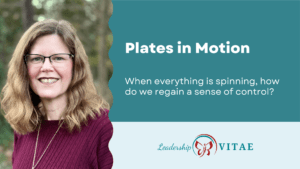
Companies each have a unique culture. Some embrace varying amounts of accountability. Others value collaboration somewhere between engagement and consensus. Many pursue some mix of the two.
High performing companies find a balanced mix between accountability and collaboration. Engaging others for input and buy-in, with clear decision-making that allows for timely action.
Collaboration – the interaction of humans with different experiences and perspectives – is critical to success, but can also be frustrating. Trying to get a diverse group of people to a common answer or plan of action? Depending on the culture of the company, this might be easier said than done.
Even with a plan for obtaining buy-in and support, it can be challenging to get to “yes” for a plan or idea. Sometimes, asking the right question can make all the difference.
Know the audience
As we begin collaborating with others, it helps to know who we’re engaging with. How we are approaching a particular project or problem may not be the same as everyone else at the table. Additionally, our motivations and drivers could be different as well.
We want to know our audience.
Consider each person we have to engage with. There are many tools out there to help, whether that’s Myers-Briggs (MBTI) NLI’s SCARF. SCARF I’ve found to be helpful to understand the threats and rewards that motivate someone.
My team of direct reports is very diverse. It was with intention, as diverse teams can help us get to better outcomes. However, that means they also each show up very differently to decision-making.
One focuses on relatedness, or the impact to people. Another on fairness, wanting to know that a solution is equitable and consistent across the organization. A third wants to understand the context to the broader goals of the team and organization.
Knowing the audience allows us to tailor our approach to what matters to them, instead of only focusing on what we value.
It never hurts to ask a question
Months ago, one of my folks worried about putting forth an idea he thought would be challenging. One that I might not support.
My advice? It never hurts to ask a question.
Instead of assuming a poor outcome, or that he wouldn’t gain support, he could try posing a question. Questions tent to help us stay open or to consider. Presenting a contentious idea might very well put someone’s back up or cause concern. But if we ask questions, then it can help them feel part of the solution.
When we know our audience, we can tailor our questions accordingly.
Conscientious collaborators
We may be interacting with someone who is conscientious. They may have concerns about a solution or plan of action, but ultimately want what’s best for the organization, customer, or team.
When interacting with conscientious collaborators, there are a few questions we can ask to help gain their support.
- “What concerns are standing in the way of a yes?”
This is the most critical question. If someone is hesitating to offer support, why? What concerns do they see that might not be obvious to others?
2. “If I address these concerns, will you support my decision?”
Once you know the concerns, this is a good follow up question. Now that they feel heard, and you’re aware and can commit to what’s been holding them back, did you get them to yes?
3. “Would you be willing to provide visible support for this effort to encourage organizational buy-in?”
The conscientious collaborators can be advocates to help with gaining further support in the organization. If there are others that need to buy-in, ask whether they’ll assist and help get to a decision or action.
Risk and perception collaborators
Some collaborators are worried about potential risks, often to themselves or their teams. The fear of failure, and negative perception, may be holding them back.
If fear is a driver, sometimes it’s best to address it head on.
4. “What is the worst that could happen? How likely is that outcome?”
Those that have a risk mindset are already looking 10 steps ahead to the train wreck that might be coming. Getting that insight up front can help build risk management into a plan or idea.
But don’t stop with knowing what could happen. Assessing risk also includes probability. If something bad could happen, but is highly unlikely, this question can help put any fears into context.
5. “How might this benefit you or your organization? How can we plan for those benefits?”
Risks are often seen as wholly negative. However, risk management includes looking for potential positive outcomes and maximizing their opportunity. By asking what good could happen, and how to increase its likelihood, that risk mindset can turn from fear to opportunity.
6. “From where you sit, do the risks outweigh the benefits I’ve outlined? What would you do shift the ratio?”
Another option, which might be successful with those that have a finance focus, or scientific approach (e.g. my actuarial friends), is to have them do the math. What is the relative risk/reward balance? What would they do to make it more palatable?
The veto collaborator
Sometimes, we run into a particularly challenging collaborator. While we’re looking for suggestions, support, and buy-in, they may be thinking they have a vote. A veto vote at that.
Ultimately, we need to understand the culture of our organization. Sometimes everyone really does have a vote. That makes accountability, decision-making, and action nearly impossible, but it does happen.
Let’s assume, however, that accountability is clear and we’ve done our best to get insights, feedback, and support. We may still get a hard no from someone that doesn’t have veto power, but thinks they do.
At this point, questions have been asked and are likely no longer effective. Instead, it’s time for a statement.
7. “I’m not asking for permission. I’m requesting your support.”
This statement provides clarity of what is being requested. Not a vote, but support for the decision, idea, or plan.
Knowing the audience is key here, because this statement can put pressure on relationships and trust. It should be used sparingly when other methods have failed.
Leave the door open
As we collaborate, it’s critical to leave ourselves open to the possibility of new insights.
If we go into interactions with an idea or position that is unmovable, we aren’t really collaborating. We are being disingenuous, checking the box of collaboration without being open to feedback and input.
The most successful collaboration is approached with an open door, prepared to meet people where they are with questions to figure out where that is.
What other questions or prompts would you recommend to actively solicit input and concerns from collaborators, while moving an idea or plan forward? Please share your thoughts in the comments.








